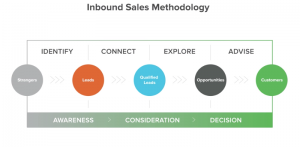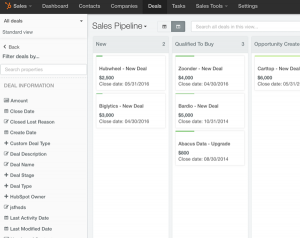
The sales process is changing dramatically, and to keep up, CMOs should now take an active role in major inbound sales functions.
In fact, companies with a strong sales and marketing alignment achieve 20% annual growth rate, according to Kapost (referencing an Aberdeen Group study).
Conversely, companies with poor sales and marketing alignment have a 4% revenue decline.
This means a big opportunity awaits CMOs who actively spearhead an inbound sales process: They can forge a sales alignment that outpaces competitors and wins over prospects, proving the value of marketing.
 By definition, inbound sales is the model of being helpful and personal during the sales process. More specifically, it involves identifying, connecting with, exploring opportunities for, and advising leads towards a sale.
By definition, inbound sales is the model of being helpful and personal during the sales process. More specifically, it involves identifying, connecting with, exploring opportunities for, and advising leads towards a sale.
In other words, inbound sales is an extension of inbound marketing: It's a chance to consult, not to sell.
To achieve this, inbound sales relies on existing data to target leads with more relevant, individualized experiences.
For example, instead of using one sales template, you would use segmentation and contact data to create a relevant sales touch. Every sales touch is based on:
So, instead of, "I think my product might help your company. When can we set up a call?" the pitch becomes, "I see you were reading articles about colocation costs. I actually have an article that breaks down the pricing models. You might enjoy it — let me know if you have any questions." It's not really a pitch after all.
CMOs can help simplify this process by prioritizing leads with lead scoring and marketing automation systems.
https://www.ironpaper.com/articles/what-is-inbound-sales/
In order to spearhead an inbound sales process, a CMO should contribute in several major ways.
 CMOs should help develop a lead scoring system to prioritize qualified leads.
CMOs should help develop a lead scoring system to prioritize qualified leads.
If you asked both the CMO and the Director of Sales what makes a qualified lead, what would they say?
Statistically, only 1 in 2 pairs would have a shared definition, according to Velocify.
As a result, marketing teams have trouble identifying qualified leads to prioritize for nurturing and sales enablement.
There's also the effect on sales teams:
Sales reps may fall short of quotas and feel discouraged by "bad leads" who who aren't truly marketing- or sales-qualified.
But on the flip side, co-writing the definition for a qualified lead is a huge opportunity for CMOs.
To do this, CMOs should meet with sales directors to identify characteristics of a qualified lead. This involves deciding:
https://www.ironpaper.com/articles/what-is-lead-scoring/
For the early stages of alignment, it is helpful for CMOs to meet regularly with sales directors and discuss leads in the system. This will help to ensure that their shared criteria for a sales-ready lead is holding up.
After sharing a definition of a qualified lead, CMOs will lay down the groundwork to create a solid list of leads who are primed for a particular sales response. And relevancy is at the heart of inbound sales.
After the definition of a qualified lead has been created, CMOs should help create the content database that will be used to target the lead.
A CMO is the business' expert in lead nurturing and drip campaigns. So it makes sense that their knowledge should inform the sales process.
Demand generation and sales training teams report the least alignment around asset/content development (34.6%), according to Corporate Visions.
CMOs should spearhead content campaigns that assist sales reps in drip campaigns, direct messages, and sales meetings or calls.
https://www.ironpaper.com/articles/using-content-nurture-sales/
For many teams, this includes creating a library of content that revolves around different topics and pain points — AKA, a database that sales can access when they need content quickly as part of a response.
These cross-team strategies will help alleviate the biggest pain point for sales teams: 65% of sales teams say they can’t locate content to use during the sales process, according to Kapost.
By investing in sales content and conversions, CMOs invest in bottom-line returns, not just on leads generated or vanity metrics like page views or bounce rates.
Many B2B companies are bogged down by long sales cycles. These long processes usually include a few common touch points: an exploratory call, a demo, a proposal.
But what happens in between the traditional stages of a sale — and is this gap in communication giving your prospects time to research competitors?
CMOs have an opportunity to create marketing workflows that keep prospects engaged. They can provide more value with content pieces like product videos, testimonials, and case studies.
To do this effectively (And at the right time), marketing teams should collaborate with sales teams on a complete sales process workflow.
Here is a breakdown of how different content pieces work well throughout the sales cycle:

 CMOs can benefit from seeing prospects move through deal stages in the CRM.
CMOs can benefit from seeing prospects move through deal stages in the CRM.
They can see which prospects are moving effectively through the pipeline, which are eventually closed successfully, and which are lost.
By comparing these leads against different data points earlier in the sales cycle, marketers can then trace back deal stages to see which marketing actions played a role.
This allows CMOs to create data about the trends that indicate a future close-won or close-lost deal. Such data feeds into a closed-loop relationship between marketing and sales.
Don’t ever let one team gather data that the other team can’t access. Sure, some marketing data is irrelevant to sales, but more often it’s not. Don’t put parameters on what either team will share… Universal access will lead to better communication and deeper insights, and will prevent duplicate work.
— Jonathan Franchell, founder and CEO of Ironpaper
Similarly, sales teams can benefit from seeing contacts in the CMS.
This is because lead data is very important to creating solid inbound sales emails. And with CMS access, sales reps can research a lead's actions to prepare a relevant message. They can also prospect ahead of an email: With historic contact data, reps may identify specific pain points to address.
Relevancy and helpfulness are the backbone of inbound sales — but this isn't possible in a sales silo. This is only achievable with good data, a sales and marketing alignment, and the help of CMOs to drive content initiatives and lead scoring.
Sources
Murphy, Anne. (2015, February 15). "10 Stats on the Business Impact of Marketing and Sales Alignment." https://marketeer.kapost.com/sales-marketing-alignment-stats/
Velocify. (2014). "CSO Insights: 2014." https://pages.velocify.com/SPOSFindMore.html?campaignid=163&kw=CSO_Find_More
Corporate Visions. (2015, January 15). "Corporate Visions Survey Finds Only 10 Percent of Companies are Completely Coordinated in Their Demand Generation and Sales Training Initiatives." https://corporatevisions.com/news/corporate-visions-survey-finds-only-10-percent-of-companies-are-completely-coordinated-in-their-demand-generation-and-sales-training-initiatives/
by Jonathan Franchell, CEO of Ironpaper - For more tips and hacks: Need to remove a new line after h1 tags? Both web designers and SEO practitioners need to employ headline tags: H1, H2, H3 in several ways to improve web page structure and tag...

The marketing industry is transforming significantly due to generative AI and increasing market complexity. Gartner's prediction of a 25% decline in traditional search traffic suggests that the era of search engines is dying. AI tools, particularly...

The Crowded Arena of the IT Marketplace Updated December 2024 The Information Technology (IT) landscape is experiencing rapid growth and intensifying competition. IT spending is projected to reach nearly 5.1 trillion U.S. dollars in 2024, a...

Updated December, 2024 The field of digital marketing is evolving rapidly in response to new technology and changing buyer expectations. To help career-minded marketers, we’ve rounded up the top 10 skills needed to succeed in the field. These are...
